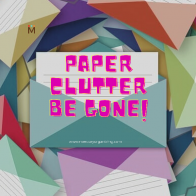Say Goodbye to Kitchen Paper Mess: Organize Like a Pro

Daily mail adds to the chaos, making the clutter feel impossible to control. Neglecting your mail can lead to missed invoices and deadlines, resulting in unnecessary fees. The stress it causes is a clear sign that it's time to find a solution. While paper clutter may never disappear entirely, and you may always have to handle some amount of it, you can manage it effectively to keep the chaos under control.
Paper clutter can be a significant source of stress for many people, especially when it accumulates and is not properly managed. The presence of clutter can create feelings of overwhelm, anxiety, and even helplessness. When paper clutter is left unattended, it can lead to a cycle of stress that only worsens over time.
According to a study published in the Journal of Environmental Psychology, clutter, including paper clutter, can lead to increased levels of cortisol, a stress hormone. The study found that individuals with cluttered homes experienced higher levels of cortisol than those with tidy homes. This journal also studied the sense of feeling at home. If your home is to make you feel “at home” by creating a sense of safety, security, and comfort, then having a cluttered home will not allow you to create the feeling you seek. The article also comments on how “personal possessions strengthen the interconnectedness between self and home (Jacobs & Malpas, 2013) unless they threaten to overwhelm the living spaces.’
Clutter is defined in this paper as an overabundance of material possessions that collectively create disorderly and chaotic home environments. When the volume of possessions becomes excessive, cluttered spaces can interfere with people's ability to execute normal life activities, such as cooking, cleaning, and moving safely through the home (Frost, Steketee, & Tolin, 2012). Instead of connectedness, clutter can create disconnectedness from important dimensions of "at-home."
Another study, published in the Journal of Personality and Social Psychology, found that cluttered environments can negatively impact mental well-being, leading to decreased focus and increased feelings of frustration and tension.
As paper clutter continues to accumulate, individuals may find it increasingly difficult to stay organized and focused, which can further contribute to feelings of stress and overwhelm. It's essential to address paper clutter promptly to prevent it from escalating and impacting your overall well-being.
With a few simple steps, you can turn your kitchen into an organized haven.
Step 1: Identify Where You Have Paper Clutter
Start by looking around your kitchen to see how much paper clutter you have. Are there piles of papers on the counter, chairs, or tables? Receipts crammed into drawers? Take a mental note of the areas that need the most help.
Step 2: Gather Your Supplies and Make the Time to Declutter
Roll up your sleeves to start by decluttering. Set aside an hour or more of uninterrupted time to get to work. Gather the necessary supplies; you'll need a trash bag, recycling bin, shredder (optional), filing folders or boxes, labels, and a pen or marker.
Step 3: Declutter Your Paper Piles
Begin by going through your paper piles, one stack at a time. Empty drawers and shelves filled with paper and envelopes. Make separate piles for what you want to keep, recycle, shred, or toss. Be ruthless! Only keep what you need or your must-have keepsakes.
Step 4: Organize Important Documents
To organize the papers you want to keep, set up a system. Use a filing cabinet or a filing box with folders to categorize documents like bills, receipts, warranties, and manuals. Create a notebook for your kids' school artwork. Label each category clearly for quick access. Stay tuned for my upcoming blog post, where I'll dive deeper into paper management strategies, providing tips on what to save and how long to keep it.
Step 5: Go Digital
Consider going digital with your important documents to reduce paper clutter. Unsubscribe to catalogs and magazines and view them online instead. Scan important papers and save them in a secure digital folder. Be sure to back up your digital files regularly. There are cloud storage companies you can use as an additional safety measure.
Step 6: Create a Kitchen Office
Designate a central area in or near your kitchen as a command center or hub for important papers and information. This could be a bulletin board, a magnetic board, or an easy-to-reach shelf. Use it to organize your menus, recipes, calendar, your kids' schedules, schoolwork, and other important notes.
Step 7: Set Up a Mail Station
Set up a dedicated spot in your kitchen office for incoming mail. Use a bin, basket, or tray to keep mail and paperwork organized. Keep a recycling bin, trash bin, and shredder nearby for easy disposal. Make it a habit to go through your mail daily, shred important documents that you won't need anymore, and recycle junk mail promptly to avoid clutter from building up.
Step 8: Maintain Regularly
Get into the habit of regularly decluttering and organizing your mail and paperwork. Set aside a few minutes each time you get your mail to open and sort through new papers immediately.
To conclude, paper clutter in your kitchen can create stress and make you feel less at home. The kitchen, being a central hub of activity, often attracts all kinds of paper clutter, from magazines, bills, and receipts to sentimental items like kids' artwork, or greeting cards. This clutter can quickly become overwhelming, especially with daily mail adding to the mix.
While you may never eliminate paper clutter, you can manage it effectively to maintain a sense of order and calm in your kitchen. By following the simple steps outlined in this guide, you can declutter your paper piles, organize important documents, and create designated areas for incoming mail and important papers. Regular maintenance and staying on top of new paperwork can help prevent clutter from building up again.
By taking control of your kitchen paper clutter, you can create a more serene and organized kitchen space, making you feel more at home and reducing stress in your daily life.





